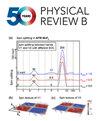手性分子导体中的电荷序和金属-绝缘体跃迁
IF 3.7
2区 物理与天体物理
Q1 Physics and Astronomy
引用次数: 0
摘要
光学测量揭示了手性分子导体[(S,S/R,R)-DM-EDT-TTF]2 ^ ClO4 (DM-Cl)和[(S,S/R,R)-DM-EDT-TTF]2 ^ ReO4 (DM-Re)中绝缘态的电荷有序性质。这些对映纯材料在室温下表现出金属导电性,在TMI=40和105 K以下冷却时分别表现出金属绝缘体转变。由于导电DM-EDT-TTF层的六角形结构,具有宽带电子激发、分子振动模式和金属相中的德鲁德成分,光学电导率谱显示出与极化无关的平面内响应。DM-Cl和DM-Re的间隙分别在150和250 cm−1处打开,表明在冷却时从金属状态转变为绝缘状态。德鲁德-洛伦兹-法诺光谱分析得到哈伯德参数、场间库仑斥力和带宽𝑊,支持绝缘相中电荷有序的存在。基于电荷敏感分子振动的DM-Cl和DM-Re的拉曼光谱进一步证实了DM-Cl和DM-Re的电荷歧化态分别为0.10±𝑒和0.13±𝑒。强DM-EDT-TTF分子模式,通过与电子背景的耦合在光谱中激活,支持晶格受挫的存在。本文章由计算机程序翻译,如有差异,请以英文原文为准。
Charge order and metal-insulator transition in the chiral molecular conductors
Optical measurements reveal the charge-ordered nature of the insulating state in the chiral molecular conductors [(S,S/R,R)-DM-EDT-TTF]2ClO4 (DM-Cl) and [(S,S/R,R)-DM-EDT-TTF]2ReO4 (DM-Re). These enantiopure materials exhibit metallic conductivity at room temperature and a metal-insulator transition upon cooling below TMI=40 and 105 K, respectively. Optical conductivity spectra display a polarization-independent in-plane response, attributed to the hexagonal structure of the conducting DM-EDT-TTF layer, featuring broadband electronic excitations, molecular vibrational modes, and a Drude component in the metallic phase. The gap opening at 150 and 250 cm−1 for DM-Cl and DM-Re, respectively, signals the transition from a metallic to an insulating state upon cooling. Drude-Lorentz-Fano analysis of the optical spectra yields Hubbard parameters, the intersite Coulomb repulsion 𝑉 and the bandwidth 𝑊, supporting the presence of charge order in the insulating phase. Raman spectra of DM-Cl and DM-Re, focusing on charge-sensitive molecular vibrations, further confirm a charge-ordered insulating state with a charge disproportionation of 0.10𝑒 and 0.13𝑒, respectively. Strong DM-EDT-TTF molecular modes, activated in optical spectra through coupling with the electronic background, support the presence of lattice frustration.
求助全文
通过发布文献求助,成功后即可免费获取论文全文。
去求助
来源期刊

Physical Review B
物理-物理:凝聚态物理
CiteScore
6.70
自引率
32.40%
发文量
0
审稿时长
3.0 months
期刊介绍:
Physical Review B (PRB) is the world’s largest dedicated physics journal, publishing approximately 100 new, high-quality papers each week. The most highly cited journal in condensed matter physics, PRB provides outstanding depth and breadth of coverage, combined with unrivaled context and background for ongoing research by scientists worldwide.
PRB covers the full range of condensed matter, materials physics, and related subfields, including:
-Structure and phase transitions
-Ferroelectrics and multiferroics
-Disordered systems and alloys
-Magnetism
-Superconductivity
-Electronic structure, photonics, and metamaterials
-Semiconductors and mesoscopic systems
-Surfaces, nanoscience, and two-dimensional materials
-Topological states of matter
 求助内容:
求助内容: 应助结果提醒方式:
应助结果提醒方式:


